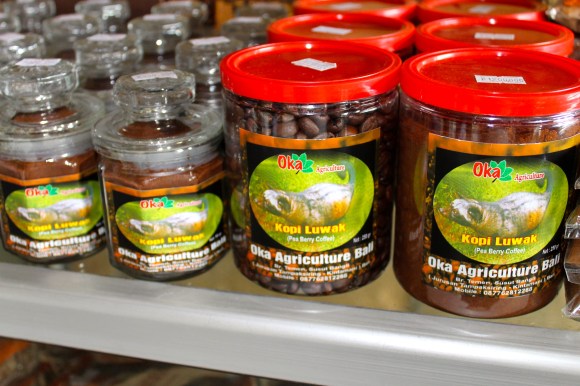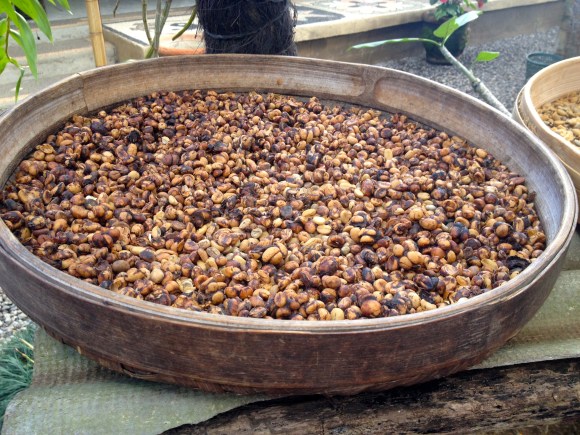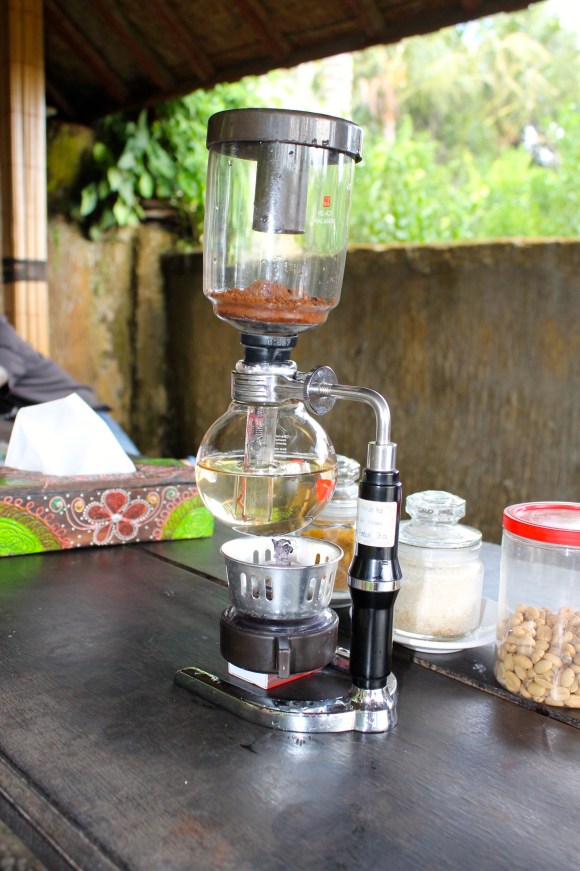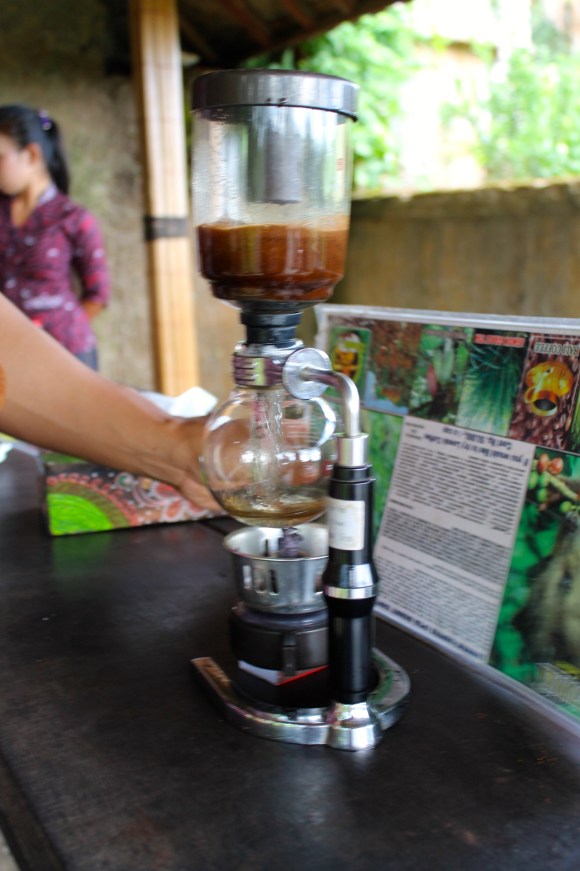
Human beings are endlessly inventive when it comes to food. From curried cicadas to snake soup to lemon and mint Pepsi, we never stop inventing new ways to follow the evolutionary imperative to stuff our faces with calories. And while I’m generally a cultural relativist when it comes to “weird” foods, sometimes there is a concept so out-there, you can’t help but say it’s bizarre.
Like kopi luwak, coffee made from beans that have been through the poop shoot of a tree cat. We’ve all heard of it, and it sounds revolting, but have any of us ever actually tried it? Why, yes, actually…
In truth, we’ve talked briefly about kopi luwak before. It’s gained global notoriety not just for the odd means of production, but also for the eye-popping prices; a steaming cup of kopi luwak can cost you upwards of US$100 at posh shops in Hong Kong and New York, earning it the descriptive nickname of “the world’s most expensive coffee.”
While visiting Indonesia recently, we were able to locate a cup at a much more reasonable 50,000 rupiah (about US$5) by going to the source: a coffee and tea plantation. At that price point, how could we not do a taste test for you, Rocketeers?
According to the staff at Oka Agriculture, civet coffee originated during the time of Dutch colonialism. Workers at the coffee plantations were forbidden from picking beans for themselves, so they would glean ones that had fallen to the ground for use at home, including the ones lodged in civet dung. They discovered that the poop coffee actually tasted different and, in their minds, better. Before long, the Dutch were drinking it as well.
▼Poop beans drying in the sun. Don’t worry, they wash them first.
Other than the step where they hang out inside a civet for a while, the beans are roasted, ground and brewed just like regular coffee.
The flavor of kopi luwak is said to be milder and rounder than typical coffee, but with an increased complexity as well. Of course, that is usually said by sales staff and insufferable coffee snobs. However, there is some evidence that the chemical makeup of the coffee is altered by its journey through the palm civet’s acidic digestive tract.
Anyway, we’ll be the judge of that.
▼One cup of poop coffee coming right up!
▼The prospect of caffeine was clearly making me too excited to hold the camera steady.
Normally, I take my coffee with cream and sugar, but in the interest of getting a clean taste test, I took this cup black.
▼Direct from the civet’s anus to your mouth!
So, how does it taste? Well, mostly it tastes like coffee. But black coffee usually has an almost metallic bitterness to me. This one didn’t have that at all. It did have a nice depth, with a nutty finish that enjoyed, at least until I started thinking of it in terms of poop.
Overall, I’d say it was a very fine cup of coffee, though not one I would pay $100 for. Frankly, even $5 was stretching it. I was happy enough thinking of it as an experiential surcharge.
It’s also worth noting that the astronomical prices have led to some unscrupulous business practices. There is apparently a lot of fake kopi luwak out there, and the pressure to increase yield has many producers in Indonesia and abroad keeping civets in battery cages and feeding them unhealthy diets, instead of the traditional method of just letting wild civets do their thing. I unfortunately discovered this after trying the coffee, but if you would like to give it a shot, do your due diligence in sourcing the beans.
For my money, there is less hassle and more value (and sugar!) in a standard cup of coffee at one of the bazillion coffee shops you will come across in Indonesia. It’s home to coffee-producing powerhouses Java and Sumatra, after all. And if you want to try something a little different, ginger coffee is a tasty and commonly available option with no feces involved, or so they tell me.
Civet image: ßlåçk Pærl/Wikicommons
Content and other images © RocketNews24






 Win a large intestine scarf from one of Japan’s leading enema manufacturers
Win a large intestine scarf from one of Japan’s leading enema manufacturers Top Asian delicacies that many consider kind of gross
Top Asian delicacies that many consider kind of gross We brave the should-be-abomination of raw egg and coffee, is it a taste sensation? 【Taste Test】
We brave the should-be-abomination of raw egg and coffee, is it a taste sensation? 【Taste Test】 Japan actually grows coffee, but how does it taste?【Taste test】
Japan actually grows coffee, but how does it taste?【Taste test】 The Osaka taste sensation that no one in Osaka has ever heard of: Coffee & Raw Egg 【Taste Test】
The Osaka taste sensation that no one in Osaka has ever heard of: Coffee & Raw Egg 【Taste Test】 Hayao Miyazaki says Happy New Year to Studio Ghibli fans with new art for Year of the Horse
Hayao Miyazaki says Happy New Year to Studio Ghibli fans with new art for Year of the Horse That time Seiji called JASRAC to ask why he didn’t get paid royalties for his song being on TV
That time Seiji called JASRAC to ask why he didn’t get paid royalties for his song being on TV Master Japanese brush makers collaborate with Peanuts for limited edition makeup brush series
Master Japanese brush makers collaborate with Peanuts for limited edition makeup brush series Draw like a Studio Ghibli anime artist with exclusive watercolour set approved by Hayao Miyazaki
Draw like a Studio Ghibli anime artist with exclusive watercolour set approved by Hayao Miyazaki Japanese group to hold fashion show of colostomy bags and other stoma equipment in Paris
Japanese group to hold fashion show of colostomy bags and other stoma equipment in Paris Criminals of Japan’s Edo Period Were Often Punished by Getting Face Tattoos
Criminals of Japan’s Edo Period Were Often Punished by Getting Face Tattoos Foreign tourist comes to Japan hoping to see yakuza from Yakuza video game series
Foreign tourist comes to Japan hoping to see yakuza from Yakuza video game series W.T.F. Japan: Top 5 kanji with ironic meanings【Weird Top Five】
W.T.F. Japan: Top 5 kanji with ironic meanings【Weird Top Five】 Starbucks Japan releases new zodiac chilled cup drink for 2026
Starbucks Japan releases new zodiac chilled cup drink for 2026 Hello Kitty Choco Egg figures are an adorable trip through three periods of Japanese pop culture【Pics】
Hello Kitty Choco Egg figures are an adorable trip through three periods of Japanese pop culture【Pics】 Starbucks Japan ready to get Year of the Horse started with adorable drinkware and plushies【Pics】
Starbucks Japan ready to get Year of the Horse started with adorable drinkware and plushies【Pics】 Cyberpunk anime meets traditional culture in Ghost in the Shell gold leaf Japanese changing screens
Cyberpunk anime meets traditional culture in Ghost in the Shell gold leaf Japanese changing screens 7 great places to see Mt. Fuji from without having to climb it
7 great places to see Mt. Fuji from without having to climb it 7-Eleven Japan’s ramen-cooking robot whipped us up a bowl of noodles【Taste test】
7-Eleven Japan’s ramen-cooking robot whipped us up a bowl of noodles【Taste test】 We found possibly the quietest Japanese-style hotel in Tokyo’s bustling Shinjuku district
We found possibly the quietest Japanese-style hotel in Tokyo’s bustling Shinjuku district Japan’s otoshidama tradition of giving kids money at New Year’s gets a social welfare upgrade
Japan’s otoshidama tradition of giving kids money at New Year’s gets a social welfare upgrade Sumo Sanrio! Hello Kitty and pals team up with Japan Sumo Association for new merch【Pics】
Sumo Sanrio! Hello Kitty and pals team up with Japan Sumo Association for new merch【Pics】 More Than a Capsule Stay: Why Solo Travelers Choose “global cabin Yokohama Chinatown”
More Than a Capsule Stay: Why Solo Travelers Choose “global cabin Yokohama Chinatown” Japan’s oldest largetooth sawfish in captivity back on display in Mie Prefecture
Japan’s oldest largetooth sawfish in captivity back on display in Mie Prefecture 7-Eleven Japan starts new temporary luggage storage service in over 300 branches
7-Eleven Japan starts new temporary luggage storage service in over 300 branches Disillusionment at Tsukiji’s tourist-target prices led us to a great ramen restaurant in Tokyo
Disillusionment at Tsukiji’s tourist-target prices led us to a great ramen restaurant in Tokyo Starbucks teams up with 166-year-old Kyoto doll maker for Year of the Horse decorations【Photos】
Starbucks teams up with 166-year-old Kyoto doll maker for Year of the Horse decorations【Photos】 Tokyo considering law requiring more trash cans following litter increase in heavily touristed area
Tokyo considering law requiring more trash cans following litter increase in heavily touristed area Tokyo’s Tsukiji sushi neighborhood asks tour groups to stay away for the rest of the month
Tokyo’s Tsukiji sushi neighborhood asks tour groups to stay away for the rest of the month Tokyo event lets you travel back in time, for free, to celebrate 100 years since Showa era start
Tokyo event lets you travel back in time, for free, to celebrate 100 years since Showa era start Sanrio theme park in Japan announces plans to expand into a Sanrio resort
Sanrio theme park in Japan announces plans to expand into a Sanrio resort Japan may add Japanese language proficiency, lifestyle classes to permanent foreign resident requirements
Japan may add Japanese language proficiency, lifestyle classes to permanent foreign resident requirements Stamina-destroying “Paralysis Noodles” are Tokyo’s newest over-the-top ramen innovation
Stamina-destroying “Paralysis Noodles” are Tokyo’s newest over-the-top ramen innovation Survey asks foreign tourists what bothered them in Japan, more than half gave same answer
Survey asks foreign tourists what bothered them in Japan, more than half gave same answer Japan’s human washing machines will go on sale to general public, demos to be held in Tokyo
Japan’s human washing machines will go on sale to general public, demos to be held in Tokyo Japan’s deadliest food claims more victims, but why do people keep eating it for New Year’s?
Japan’s deadliest food claims more victims, but why do people keep eating it for New Year’s? We deeply regret going into this tunnel on our walk in the mountains of Japan
We deeply regret going into this tunnel on our walk in the mountains of Japan Studio Ghibli releases Kodama forest spirits from Princess Mononoke to light up your home
Studio Ghibli releases Kodama forest spirits from Princess Mononoke to light up your home Major Japanese hotel chain says reservations via overseas booking sites may not be valid
Major Japanese hotel chain says reservations via overseas booking sites may not be valid Put sesame oil in your coffee? Japanese maker says it’s the best way to start your day【Taste test】
Put sesame oil in your coffee? Japanese maker says it’s the best way to start your day【Taste test】 No more using real katana for tourism activities, Japan’s National Police Agency says
No more using real katana for tourism activities, Japan’s National Police Agency says Starbucks Japan reveals new sakura drinkware collection, inspired by evening cherry blossoms
Starbucks Japan reveals new sakura drinkware collection, inspired by evening cherry blossoms Updated cherry blossom forecast shows extra-long sakura season for Japan this year
Updated cherry blossom forecast shows extra-long sakura season for Japan this year Put sesame oil in your coffee? Japanese maker says it’s the best way to start your day【Taste test】
Put sesame oil in your coffee? Japanese maker says it’s the best way to start your day【Taste test】 Transparent coffee! We taste-test Asahi’s Clear Latte, marvel at Japanese drinks wizardry
Transparent coffee! We taste-test Asahi’s Clear Latte, marvel at Japanese drinks wizardry Coffee-infused rice for rice balls and curry? Taste-testing a recipe from Japan’s coffee experts
Coffee-infused rice for rice balls and curry? Taste-testing a recipe from Japan’s coffee experts How does 27-year-old coffee taste? We find out with another fearless taste test 【Video】
How does 27-year-old coffee taste? We find out with another fearless taste test 【Video】 Meg tries out Starbucks Japan’s newest treat: the White Brew Coffee and Macadamia Frappuccino
Meg tries out Starbucks Japan’s newest treat: the White Brew Coffee and Macadamia Frappuccino Starbucks vs. Tully’s — Is there such a big difference between Japan’s coffee giants?【Taste test】
Starbucks vs. Tully’s — Is there such a big difference between Japan’s coffee giants?【Taste test】 In Japan, you can now get Coca-Cola pre-mixed with coffee【Taste test】
In Japan, you can now get Coca-Cola pre-mixed with coffee【Taste test】 Starbucks’ retro Japanese kissaten menu debuts deliciously mature coffee gelatin cake【Taste test】
Starbucks’ retro Japanese kissaten menu debuts deliciously mature coffee gelatin cake【Taste test】 We tried Japan’s first nitro cold-brew coffee at the Starbucks in Tokyo’s new GINZA SIX
We tried Japan’s first nitro cold-brew coffee at the Starbucks in Tokyo’s new GINZA SIX We Try Beer Made with Coffee from an Elephant’s Butt!
We Try Beer Made with Coffee from an Elephant’s Butt! New coffee order: Freemason Coffee on sale in Japan in June
New coffee order: Freemason Coffee on sale in Japan in June We try ramen from a can on the backstreets of Tokyo【Taste Test】
We try ramen from a can on the backstreets of Tokyo【Taste Test】 We tried out the new Starbucks Cold Brew “Lime” coffee and it tasted unexpectedly refreshing
We tried out the new Starbucks Cold Brew “Lime” coffee and it tasted unexpectedly refreshing Who wins in a battle of McDonald’s and Komeda Coffee’s chicken tatsuta burgers?【Taste test】
Who wins in a battle of McDonald’s and Komeda Coffee’s chicken tatsuta burgers?【Taste test】 Pizza Hut Japan’s new Wiener Coffee Pizza tastes as crazy as it sounds
Pizza Hut Japan’s new Wiener Coffee Pizza tastes as crazy as it sounds
Leave a Reply